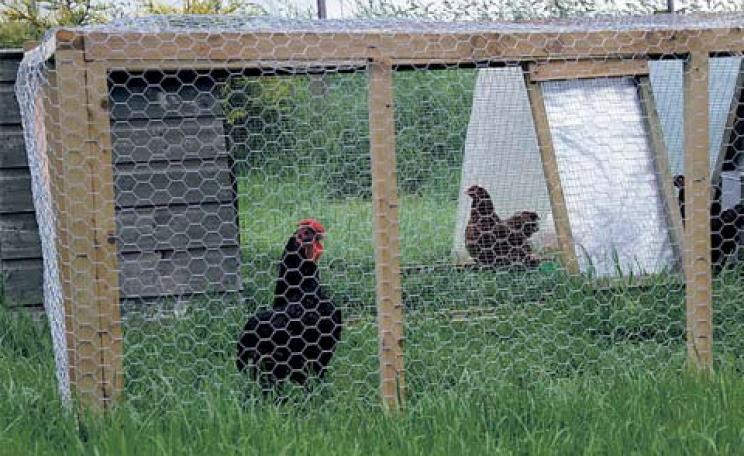Grow maize in a corner of your vegetable garden where it makes a splendid windbreak
If you have the space you can grow a few grain crops, and if you don’t, you can always sprout them. I once worked on a charter yacht in the Caribbean and learned that if you wanted fresh salad stuff, your best bet was to sprout grains in the fo’c’s’le (the upper deck of a sailing ship). Most grain crops, such as wheat, barley and alfalfa are capable of sprouting and all make excellent and healthy food.
Barley
Barley has a variety of uses and is the easiest of the grass-grain crops to grow as it does not need as good a soil as, for example, wheat. Barley is the earliest cultivated grass and the one that was the most sacred to the Earth-Mother and to other gods. It is also arguably the most beautiful of the grain crops, with its long bearded heads waving like silk in the breeze. Endless songs and poems have been written about this.
Cultivation
Barley is planted either in spring or autumn. Autumn-planted, or winter barley as it is called, remains dormant until the spring and gives higher yields but poorer quality grains. It is harvested in July and is mostly rolled for animal feed. Spring barley is harvested in August. It gives lower yields of better quality grains and is malted for the food, brewing and whisky industries, where it fetches a good price.
If you want to grow barley in your field you must plough the land, cut the drills, then plant the seed and roll it. It can be grown as a continuous crop but is more usually found as a three-year rotated crop in a cycle beginning with wheat, then barley, then sugar beet or peas. If you have the space it is a rewarding crop to grow. If you grow a lot, send it away to be milled otherwise you can let it dry and make yourself a quern or stone handmill. Barley straw is tougher and less brittle than wheat straw and at a pinch can be chopped for animal fodder.
As food
Barley as food is very diverse. Bere flour made from barley was the main grain of the Highlands of Scotland and of much of Scandinavia and Northern Russia. Barley bannocks were cooked either on a griddle or in the embers of the fire. The flour does not leaven much.
Two types of food barley exist. There is pot barley, also know as Scots barley or, in Italy, as faro. It is used in soups and stews. Polished barley, which has had most of the husk removed, has less flavour but is used in baby food and porridge.
Barley porridge is more digestible than oats and was traditionally made with milk and fed to invalids as gruel. The Sephardic Jews celebrated the cutting of a baby’s first tooth with a dish called belita which is a sweetened barley porridge with nuts and fruit. Barley can also be cooked with ale to make a thick savoury porridge, which is very good as a staple instead of rice or potatoes. There was a trend a few years ago among chefs for barley risotto; I am glad to say it has sunk without trace.
Malt vinegar for pickling and sprinkling on fish and chips is also made from milled barley.
Malted barley
Grow maize in a corner of your vegetable garden where it makes a splendid windbreak
Malted barley is largely made commercially nowadays. The process involves soaking the grains until they chit, in other words until the roots burst through the skin (remember potatoes). Heat is then applied in a kiln to kill the embryo and the grain is either milled for brewing or distilling, or is left whole or cracked for baking.
Maize and sweetcorn
Zea, or maize, in all its forms is native to the American continents and was allegedly brought back to Spain by the conquistador Pizarro, who found it in Peru. It is the staple grain of southern and central America and of the southern states of America. The pantheistic Amerindians saw it as a young and fertile warrior.
Cultivation
In the UK maize will grow south of the Mersey-Humber line on sites lower than 125 metres. Although there are hybrids that will grow further north, this is uncommon. It prefers rich, loamy soil but will do quite well in drier soils. It will not grow in compacted soils and dislikes heavy wet clays.
Grow maize in a corner of your vegetable garden where it makes a splendid windbreak for delicate plants. The same applies to sweetcorn cultivation as to maize, especially when it comes to pollination problems, but the ears ripen earlier and should be picked when almost ripe.
Plant in spring 100–125cm apart and in deep drills. Obviously this can be done by machine if you have a large field. Keep the rows free of weeds until the plants are well established.
In the northern hemisphere the corn is harvested in late October to early November and because of the climate, it must then be dried in a warm dry barn by being spread out and turned. The stalks are cut and the ears stripped by hand.
The grains can either be ground for cornflour or eaten as hominy grits or polenta. The liquid in the stalks is made into corn syrup or liquid glucose but unless you have a press, this is not for domestic production. Alternatively, the head can be eaten as a vegetable, as corn on the cob, or the stripped grains are eaten as niblets. Don’t cook corn on the cob with salt as this will toughen it.
Pollination problems
Maize must be grown in a block as the ears grow low down and are covered and surrounded by fleshy leaves, with male and female plants quite far apart. This means that the wind may not catch the pollen and there may be pollination problems. It is due to this as much as dehydration that maize doesn’t thrive in seaside or windy sites. There are no self-pollinating Zeas and due to the proliferation of GM maize in the USA there is a good market there for organic maize.
Oats
This is the grain which the misogynistic Dr Johnson said is eaten by men in Scotland and horses in England. Poor old Dr J. It has now been proved that the presence of beta glucan in oats dramatically lowers cholesterol, especially LLD or ‘bad’ cholesterol, reduces blood pressure and is a cancer-deterrent, so eat your porridge every day. And as well as its health-giving qualities, it also guards against adhesions on operation scars and is good in the treatment of non-insulin dependent diabetes.
Wild oats have grown in Asia and the Middle East for thousands of years and were first cultivated for food in the first century AD. Only 5 per cent of the oat crop worldwide is now used for human consumption; the rest is fed to animals. Oat straw is a very good straw to use for animal bedding.
Cultivation
If you have the right climate and the land, and want to grow oats, it is a rewarding crop. Nowadays people in towns can buy wild oats for the patio; they look pretty, attract wild birds and are an endless source of jokes!
Oats grow well in marginal soil and cool damp climates but will tolerate cool and dry. They dislike copper deficiency in the soil but will endure everything else, but don’t plant them where the pH in the soil is above level 7.
The plant, which grows to about 1 metre tall, is sown as either winter oats in the autumn or spring oats. In either case it should be sown as early as possible in the growing season.
Know your oats
Oatmeal comes in different weights.
Pinhead oatmeal – used in haggis and oaten loaves, but needs overnight soaking for porridge
Rough oatmeal – used for porridge or broase (a type of thickened soup)
Medium oatmeal – used for oat pudding
Medium-fine oatmeal – used for porridge, broase, skirlie (where it is fried with onion and used as a side-dish or a stuffing) and oatcakes
Fine oatmeal – used mixed with coarser oat flour or wheatflour for oatcakes. Porridge oats are partially steamed and re-dried for quicker cooking
Eat your oats
Groat sausages, also called Hogs Pudding and which are native to southern Devon, are made with whole oats. A drink made from oat husks, called ‘sowans’ in England and ‘brewis’ in Wales, was regarded by country people as very heartening and warming on a cold night.
Protect your apples with wheat
You might consider growing your wheat among newly planted apple trees. Scientific research shows that where you plant new trees to replace old apple trees in an established orchard the trees won’t flourish without the use of chemical anti-microbe treatments. However, if you plant wheat between the trees, an enzyme in the wheat kills the microbes and the trees flourish.
This is an edited extract from A Greener Life by Clarissa Dickson Wright and Johnny Scott (Kyle Cathie, £16.99) with photography by Vanessa Courtier.
Ecologist readers can buy the book at the special price of £14.99 inc free p&p (UK mainland only).
To order your copy, ring: 01903 828503, quoting ref. KC AGL/ECO or email: mailorders@lbsltd.co.uk
For ethical and sustainable suppliers of home and garden products and services check out the Ecologist Green Directory here




